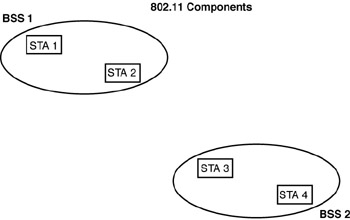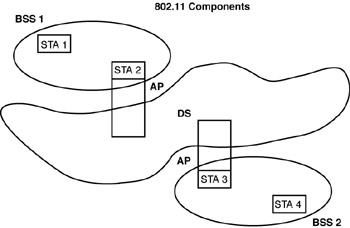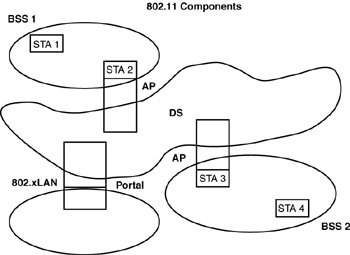Components of the IEEE 802.11 Architecture
|
|
The IEEE 802.11 architecture consists of several components that interact to provide a WLAN that supports station mobility transparently to upper layers. The basic service set (BSS) is the basic building block of an IEEE 802.11 LAN. Figure 5-2 shows two BSSs, each of which has two stations that are members of the specified BSS. It is useful to think of the ovals used to depict a BSS as the coverage area within which the member stations of the BSS may remain in communication. (The concept of area, although not precise, is often good enough.) If a station moves out of its BSS, it can no longer directly communicate with other members of the BSS.

Figure 5-2: BSSs
The Independent BSS (IBSS) as an Ad Hoc Network
The IBSS is the most basic type of IEEE 802.11 LAN. A minimum IEEE 802.11 LAN may consist of only two stations that communicate directly with each other. Figure 5-2 shows two IBSSs (in this case, the BSS is actually an IBSS since there is no centralized device—an access point—that controls communication). This mode of operation is possible when IEEE 802.11 stations are able to communicate directly. Because this type of IEEE 802.11 LAN is often formed without preplanning, for only as long as the LAN is needed, this type of operation is often referred to as an ad hoc network.
STA to BSS Association Is Dynamic The association between an STA and BSS is dynamic (STAs turn on, turn off, come within range, and go out of range). To become a member of an infrastructure BSS, a station needs to become associated. These associations are dynamic and involve the use of the distribution system service (DSS).
Distribution System (DS) Concepts
PHY limitations determine the direct station-to-station distance that may be supported. For some networks, this distance is sufficient; for other networks, increased coverage is required. Instead of existing independently, a BSS may also form a component of an extended form of network that is built with multiple BSSs. The architectural component used to interconnect BSSs is the distribution system (DS).
IEEE 802.11 logically separates the WM from the distribution system medium (DSM). Each logical medium is used for different purposes by a different component of the architecture. The IEEE 802.11 definitions neither preclude, nor demand, that the multiple media be either the same or different.
Recognizing that the multiple media are logically different is key to understanding the flexibility of the architecture. The IEEE 802.11 LAN architecture is specified independently of the physical characteristics of any specific implementation. The DS enables mobile device support by providing the logical services necessary to handle address-to-destination mapping and seamless integration of multiple BSSs. An AP is an STA that provides access to the DS by providing DS services in addition to acting as an STA.
Figure 5-3 adds the DS and AP components to the IEEE 802.11 architecture picture. Data move between a BSS and the DS via an AP. Note that all APs are also STAs; thus, they are addressable entities. The addresses used by an AP for communication on the WM and DSM are not necessarily the same.

Figure 5-3: DSs and APs
Extended Service Set (ESS): The Large Coverage Network The DS and BSSs allow IEEE 802.11 to create a wireless network of arbitrary size and complexity. IEEE 802.11 refers to this type of network as the extended service set (ESS) network.
The key concept is that the ESS network appears the same to an LLC layer as an IBSS network. Stations within an ESS may communicate and mobile stations may move from one BSS to another (within the same ESS) transparently to LLC.
802.11 assumes nothing about the relative physical locations of the BSSs in Figure 5-4. All of the following are possible:
-
The BSSs may partially overlap. This is commonly used to arrange contiguous coverage within a physical volume.
-
The BSSs could be physically disjointed. Logically, there is no limit to the distance between BSSs.
-
The BSSs may be physically collocated. This may be done to provide redundancy.
-
One (or more) IBSS or ESS networks may be physically present in the same space as one (or more) ESS networks. This may arise for a number of reasons. Two of the most common are when an ad hoc network is operating in a location that also has an ESS network and when physically overlapping IEEE 802.11 networks have been set up by different organizations.

Figure 5-4: ESS
Area Concepts
For wireless PHYs, well-defined coverage areas simply do not exist. Propagation characteristics are dynamic and unpredictable. Small changes in position or direction may result in dramatic differences in signal strength. Similar effects occur whether an STA is stationary or mobile (as moving objects may impact station-to-station propagation). Since dynamic three-dimensional field strength pictures are difficult to draw, well-defined two-dimensional shapes are used in IEEE 802.11 architectural diagrams to represent the coverage of a BSS.
Integration with Wired LANs
To integrate the IEEE 802.11 architecture with a traditional wired LAN, a final logical architectural component is introduced — a portal. A portal is the logical point at which MSDUs from an integrated non-IEEE 802.11 LAN enter the IEEE 802.11 DS. For example, the portal in Figure 5-5 is connecting to a wired IEEE 802 LAN. All data from non-IEEE 802.11 LANs enter the IEEE 802.11 architecture via a portal. The portal provides logical integration between the IEEE 802.11 architecture and existing wired LANs. It is possible for one device to offer the functions of an AP and a portal; this could be the case when a DS is implemented from IEEE 802 LAN components.

Figure 5-5: Connecting to other IEEE 802 LANs
The ESS architecture (APs and the DS) provides traffic segmentation and range extension. Logical connections between 802.11 and other LANs are via the portal. Portals connect between the DSM and the LAN medium that is to be integrated.
|
|
EAN: N/A
Pages: 88